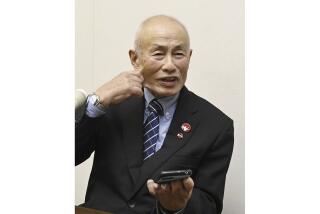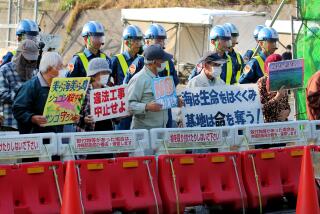Commitment, Complacency in Hiroshima
HIROSHIMA, Japan — Heads bowed in prayer and memory, the citizens of this self-styled City of Peace fell silent at 8:15 local time this morning, 60 years from the instant of the atomic flash that vaporized the heart of their city and dragged mankind over the precipice into the nuclear age.
Temple bells that had been ringing for the dead stopped to mark the moment when an American B-29 bomber dropped its atomic cargo over Hiroshima, killing 70,000 people on the spot from concussion and fire and debris. Another 70,000 died within months from the effects of radiation.
It was also an act that many argue hastened an end to a world war that had already claimed millions.
A onetime garrison town for Japan’s Imperial Army, Hiroshima has since turned its tragedy into a platform for peace and nuclear disarmament. The cry was made more poignant this year by the advancing ages of the hibakusha, or “bomb-affected people.”
Hiroshima Mayor Tadatoshi Akiba called the ceremony a “time of inheritance, of awakening and of commitment, in which we inherit the commitment of the hibakusha to the abolition of nuclear weapons and recommit ourselves to take action.”
But there is also an uneasy sense among many here that Japan’s collective pacifist voice has become shaky with age. The last witnesses to the atomic attacks are increasingly infirm or dying, with little sign that the country’s unique experience of having been attacked with atomic weapons resonates with younger generations.
“I think they regard preventing war as someone else’s problem,” said Taichi Ueno, 24, part of a small group of peace activists called P-Souls who traveled to Hiroshima for the ceremony. “About war, they say, ‘It wouldn’t happen to me.’ ”
Indeed, peace activists note a ritualistic feel to the annual commemoration. The national broadcaster, NHK, carried the ceremony live, but cut away from the speeches appealing for peace after just 20 minutes, returning to its regularly scheduled drama series called “Fight.” Even some residents of Hiroshima, where what the Japanese call peace education in schools is more intensely followed than elsewhere, sound jaded.
“Only on this day are people enthusiastic about peace -- that’s it,” said Yuki Shibazaki, 17, as she gossiped with friends around the Peace Memorial Museum after the ceremony. Her high school class was supposed to designate two representatives to attend Saturday’s ceremony, but there were no volunteers.
“I don’t have any clear sense about war or peace,” she said. “To be honest, for the locals, it is an inconvenience and annoying to have a ceremony like this.”
That sentiment worries Hiroshima survivors, who warn that complacency about the lessons of the atomic bombs make war and even the use of nuclear weapons more likely.
“Japanese people are surprisingly passive,” said Yasuhiro Okudaira, 76, who heads the Article 9 Assn., a coalition of civic groups fighting to guard the constitutional clause that renounces Japan’s right to wage war or use the threat of force to resolve international conflicts. “I don’t think youngsters are necessarily nationalistic. It is just that they are sort of free riders, interested only in their own small lives, not the larger philosophical questions.”
The apathy is measurable. Annual attendance at Hiroshima’s peace memorial peaked at 1.59 million in 1991 and has fallen to barely more than a million in each of the last five years -- with foreign visitors accounting for one-tenth of the total.
Some school administrators complain that their students get bored spending a full day in Hiroshima’s museum looking at photographs and reading witness accounts. There are some in Hiroshima who now argue that the peace memorial needs other diversions for students visiting on day trips (a zoo is one suggestion) to try to boost attendance.
Older Japanese argue that an atomic blast site should be enough of a theme park to hold a teenager’s attention.
“I have heard the argument that there is nothing to see at the peace park other than the museum and I think that misses the point,” said Motofumi Asai, 64, a former diplomat and now director of the Hiroshima Peace Institute. “The students must see the materials in detail. They must be moved fundamentally by the Hiroshima victims.”
This has been a somber year for World War II anniversaries in Japan, with nothing but calamity to commemorate: the March 1945 firebombing of Tokyo that killed an estimated 100,000 citizens; gruesome losses during battles for Saipan and Okinawa; and, this month, the incineration of Hiroshima and Nagasaki followed by surrender.
But even the most devoted peace activists acknowledge the diminution of the Hiroshima experience in the Japanese consciousness. And they note that the increased cases of vandalism at the peace park -- origami cranes made by children in memory of victims have been set on fire -- show a diminishing reverence for the tragedy.
In the vacuum left by apathy, right-wing activists have taken the wheel of the political agenda, pushing for a reassertive Japanese nationalism.
Junior high school history textbooks are being rewritten to soften Japan’s wartime role. And there is a strong push to rewrite the pacifist Article 9.
The drive is to make Japan a “normal” state again, with real armed forces capable of projecting Japanese power in Asia and beyond, not the constitutionally restricted Self Defense Force. Some of those who attended Saturday’s ceremony noted the change in the national mood as Hiroshima moves from memory into myth.
Hiroshima resident Isao Sakoda, 67, still remembers that morning as a boy, when, he said, the sky went dark, black rain and other particles began falling from the sky, and his mother yelled at him to not touch anything. He remembers the suffering of a neighbor, badly burned, the skin peeling off her back.
But he said he understood the difficulty in conveying the horror to those who did not see it with their own eyes.
“When you are not in danger, you don’t have any sense of crisis,” Sakoda said. “It is easy to forget, and people are forgetting the pain.
“But somehow,” he said, “we have to make sure that young people around the world do not forget Hiroshima.”
Naoko Nishiwaki of The Times’ Tokyo Bureau contributed to this report.
More to Read
Sign up for Essential California
The most important California stories and recommendations in your inbox every morning.
You may occasionally receive promotional content from the Los Angeles Times.










